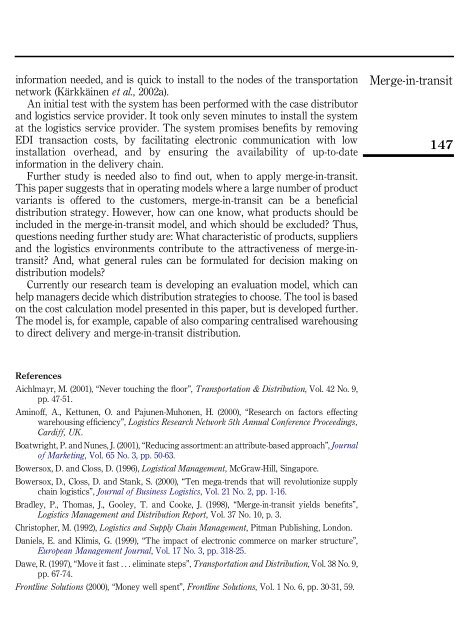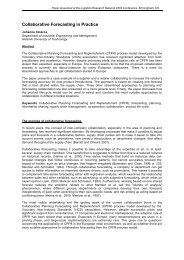Increasing customer value and decreasing distribution costs ... - LRG
Increasing customer value and decreasing distribution costs ... - LRG
Increasing customer value and decreasing distribution costs ... - LRG
You also want an ePaper? Increase the reach of your titles
YUMPU automatically turns print PDFs into web optimized ePapers that Google loves.
information needed, <strong>and</strong> is quick to install to the nodes of the transportationnetwork (Kärkkäinen et al., 2002a).An initial test with the system has been performed with the case distributor<strong>and</strong> logistics service provider. It took only seven minutes to install the systemat the logistics service provider. The system promises bene®ts by removingEDI transaction <strong>costs</strong>, by facilitating electronic communication with lowinstallation overhead, <strong>and</strong> by ensuring the availability of up-to-dateinformation in the delivery chain.Further study is needed also to ®nd out, when to apply merge-in-transit.This paper suggests that in operating models where a large number of productvariants is offered to the <strong>customer</strong>s, merge-in-transit can be a bene®cial<strong>distribution</strong> strategy. However, how can one know, what products should beincluded in the merge-in-transit model, <strong>and</strong> which should be excluded? Thus,questions needing further study are: What characteristic of products, suppliers<strong>and</strong> the logistics environments contribute to the attractiveness of merge-intransit?And, what general rules can be formulated for decision making on<strong>distribution</strong> models?Currently our research team is developing an evaluation model, which canhelp managers decide which <strong>distribution</strong> strategies to choose. The tool is basedon the cost calculation model presented in this paper, but is developed further.The model is, for example, capable of also comparing centralised warehousingto direct delivery <strong>and</strong> merge-in-transit <strong>distribution</strong>.Merge-in-transit147ReferencesAichlmayr, M. (2001), ªNever touching the ¯oorº, Transportation & Distribution, Vol. 42 No. 9,pp. 47-51.Aminoff, A., Kettunen, O. <strong>and</strong> Pajunen-Muhonen, H. (2000), ªResearch on factors effectingwarehousing ef®ciencyº, Logistics Research Network 5th Annual Conference Proceedings,Cardiff, UK.Boatwright, P. <strong>and</strong> Nunes, J. (2001), ªReducing assortment: an attribute-based approachº, Journalof Marketing, Vol. 65 No. 3, pp. 50-63.Bowersox, D. <strong>and</strong> Closs, D. (1996), Logistical Management, McGraw-Hill, Singapore.Bowersox, D., Closs, D. <strong>and</strong> Stank, S. (2000), ªTen mega-trends that will revolutionize supplychain logisticsº, Journal of Business Logistics, Vol. 21 No. 2, pp. 1-16.Bradley, P., Thomas, J., Gooley, T. <strong>and</strong> Cooke, J. (1998), ªMerge-in-transit yields bene®tsº,Logistics Management <strong>and</strong> Distribution Report, Vol. 37 No. 10, p. 3.Christopher, M. (1992), Logistics <strong>and</strong> Supply Chain Management, Pitman Publishing, London.Daniels, E. <strong>and</strong> Klimis, G. (1999), ªThe impact of electronic commerce on marker structureº,European Management Journal, Vol. 17 No. 3, pp. 318-25.Dawe, R. (1997), ªMove it fast . . . eliminate stepsº, Transportation <strong>and</strong> Distribution, Vol. 38 No. 9,pp. 67-74.Frontline Solutions (2000), ªMoney well spentº, Frontline Solutions, Vol. 1 No. 6, pp. 30-31, 59.




